Are these the 10 best streets in Europe?
EL PAÍS correspondents choose their favorite thoroughfares in the cities where they live
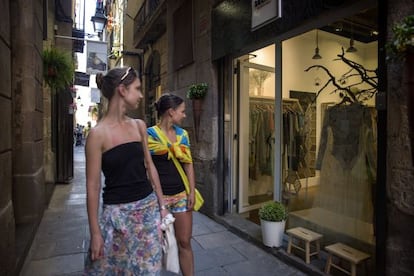
Streets that have an air of freedom and the good life to them; streets that are best explored on foot or on two wheels; streets where the influence of local entrepreneurs is clear to see, and that embody the spirit of the cities of which they are part.
Streets with views, like Dom Pedro V in Lisbon, which ends at the city’s best vantage point. Or a street distinguished by a baroque arcade and cobblestones, such as Conde Duque in Madrid.
Or in Barcelona, the small, narrow Flassaders street, along which visitors discover the atmosphere of the little shops in the Born neighborhood. Or, in Vienna, a hill, with Spittelberg street as its axis, where the most famous Christmas market of the Austrian capital finds its home.
And a London thoroughfare, Chiltern Street, where locals have managed to keep out the big chains in favor of small, original craft stores.
Ten suggestions for streets where you can shop, see an exhibition, or sit on a terrace enjoying a book or a chat. The celebration of a relaxed – and genuinely European – way of life.
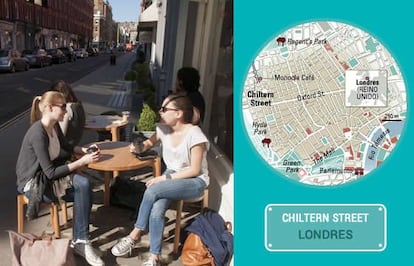
Neighborhood chic
By Pablo Guimón
There are few hidden gems left to discover in central London – the cool hunters have been heading to the outskirts for some time now. But there are exceptions. And Chiltern Street is one of them. This road, full of impressive neo-Gothic Victorian red-brick buildings is an oasis of calm in the midst of Marylebone, and is home to some of the city’s most exclusive stores. It’s an elegant street, without ostentation, and its cosmopolitan occupants have been carefully chosen – international chains have been forbidden from setting up shop here.
Located between Baker Street and Marylebone High Street, the road owes a lot of its transformation to the guru of global good taste, Tyler Brûlé. Just around the corner, in Dorset Street, are the London offices of Monocle magazine, which he created. Several years ago, this led to the opening of the Monocle Café, a small establishment that is almost a caricature of the lifestyle reflected in the magazine. “Marylebone High was becoming too expensive and crowded,” explains Brûlé. “Chiltern allows you to be a bit further away from all that, it’s more peaceful. There is a special kind of community atmosphere, everyone here knows each other and we all get on.”
Another star from the exquisite Monocle galaxy already orbited around Chiltern Street. Trunk is a cult establishment in the world of men’s fashion, with clothes that its director, Mats Klingberg – Brûlé’s partner – sources from all over the world. “We offer a selection of modern classics, avoiding passing fashions,” explains Klingberg. Thanks to the success of the store, in 2013 another branch opened up on the same street, dedicated to accessories. These stores, as well as others such as John Simmons, Sunspel and Grey Flannel, have made Chiltern Street an essential destination for anyone seeking quality menswear in London.
But there is another factor that has put this street on the London cool map: the opening of the boutique hotel Chiltern Firehouse by American André Balazs, famous for his restorations of emblematic buildings. This establishment is housed in a former fire station, and is one of the most important surviving examples of the late 19th-century neo-Gothic style. Its restaurant, run by award-winning chef Nuno Mendes, is a favorite with celebrities.
But every establishment on Chiltern Street is worth a visit. Music-lovers will find an amazing array of wind instruments, accessories and sheet music at Howarth of London, a world-renowned oboe-maker since 1948. Or, for something more exotic, there are Indian instruments at JAS Musicals. Cadenhead’s, Scotland’s oldest independent whisky bottler, has its London branch here, while in Cire Trudon you can buy the finest handmade candles.
Wedding and beauty stores, as well as the Javier Salvador floral art studio, hint at the street’s past, when it specialized in wedding fashions. Meanwhile, the Atlas gallery is one of London’s most important photography specialists.

Le Marais and its secret gardens
By Gabriela Cañas
In the heart of Paris’s fashionable Le Marais district is a humble street where Haussmann-style buildings do not line up majestically as they do elsewhere. On Rue des Francs-Bourgeois, it is possible to shop without going bankrupt, to gaze at the imposing stone buildings, to stop for a bite at any time of the day, and above all, to entertain the feeling that you are discovering one of those secret city corners that Parisians cherish so dearly.
The street only has 60 numbers, so walking its length will not tire anyone out. But it’s best not to let yourself get caught up by the storefronts and stony façades of the Musée des Archives or the Albret palace. Uniqlo, Japan’s informal answer to Spanish fashion retailer Zara, is a recommended stop here, and not just because of its affordable prices. These particular premises afford an opportunity to discover part of the city’s entrails. Go down to the basement. This building once belonged to the Société des Cendres, literally the Society of Ashes, a cooperative of jewelers and watchmakers who used the basement facilities to dispose of the waste from their gold and silversmithing work. The old machinery they used to melt down the precious metals is on display here, giving visitors a glimpse of the area’s Jewish history.
There is nothing special about the front of the Le Dôme du Marais restaurant, located at 53, Rue des Francs-Bourgeois, yet its interior is a surprising circular space with a see-through dome that has been meticulously decorated. Also, do not walk by number 8 without stopping. This building contains a typically Parisian courtyard with an art gallery specializing in photography, YellowKorner, and an enormous, well-kept haberdashery, heir to the spinners who lived in this area in the 15th century. The street is also home to tiny, almost invisible gardens that crop up in the most unlikely spots.
Strolling down the Rue des Francs-Bourgeois, which leads to Place des Vosges, is particularly pleasant on Sundays, when the street is closed off to traffic and a band adds to the ambient noise. The music is good, but what makes the moment extraordinary is the old woman dancing along to it. Monsieur Pierre, owner of Bistrot Camille, at number 24, has the following advice: “You have to come here at night as well. It has a most particular charm.”

Kraftwerk at the market
By Luis Doncel
You don’t fall in love with Berlin because of its streets. This isn’t Paris or Rome, cities that look like they were designed to leave passers-by with their mouths wide open. What’s interesting here are the establishments that spring up on every corner – the cafés where you can spend whole afternoons, or extraordinary buildings such as the Neue Nationalgalerie. That’s why it’s hard to choose just one street. But if you have to pick one, I would probably go for Swinemünder Straße.
At first sight, there’s nothing special about it. I like it because, despite being located in the gentrified Mitte neighbourhood, it still has houses that haven’t been refurbished, which gives you a – vague – idea of what this area on the eastern side of the city must have been like 25 years ago, when it was one of the poorest parts of the capital. Those who have spent more time here say they now see that era as though it were in black and white.
A wander down the street starts at the Sion church. This evangelical temple dates from the times of Kaiser Wilhelm I, and was made famous in the 1980s, when its basement was home to a clandestine printing press from which leaflets and magazines critical of the Communist regime were distributed.
Leaving the church behind, the façade of the buildings on the left starts to change color – granite, blue, green... – under the shadow of gigantic maple trees, which, as is the norm in Berlin, are higher than the buildings.
A few meters on, at number 120, lives Ilona Fichtner. The leader of the GDR, Erich Honecker, enjoyed a coffee in her front room on February 9, 1984, to commemorate the two million homes that had been refurbished by the state.
Then the Arkonaplatz appears, which is where one of the city’s most charming markets is held every Sunday. To the sound of Kraftwerk’s Autobahn coming out of a record player up for sale, visitors can browse old comics or a copy of Der Spiegel from the week the 9/11 attacks took place.
As with so many streets in this metropolis of long avenues, a wander along Swinemünder is a great way to get to know a number of different Berlins. Past the luxury apartments that were built recently around Bernauer Straße, the street narrows, turning into a green area that leads into Wedding, the neighborhood that, years ago, said it would be the next one to become fashionable, but never quite made it.
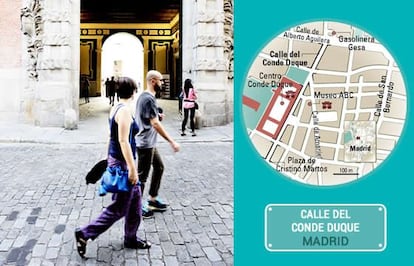
Modern meets baroque
By Mercedes Cebrián
Given the chance to get to know just one street in Madrid, why would anyone choose Calle de Conde Duque? Well, for one thing, because its southern end opens up into Plaza de Cristino Martos, that elevated viewpoint whose stone staircase leads down to Princesa street, very near Plaza de España, yet which also isolates you from the morass of chain stores that reign down below. And for another, because if you walk in the other direction at night, you come face to face with a luminous apparition: Gesa, a small, rationalist-design gas station created in 1927 by Casto Fernández-Shaw and successfully restored in the 1990s.
And between those two ends lies everything that defines Madrid, which is to say, not just fin-de-siècle buildings dotted with wrought-iron balconies, but also brick-studded blocks with closed-up terraces, flimsy little trees that hold the promise of future growth, and archetypal Galician and Asturian bars, complete with traditional breast-shaped cheeses (quesos de tetilla) lining the windows to entice passers-by.
A number of veteran establishments remain, including El Jardín Secreto, a café with a fairyland setting highly recommended for those on first dates hoping to steal a first kiss. Another enduring business is Sportivo, one of the first stores to offer young Madrileños imported clothing and apparel. Occupying the next block is a shoe store named Duke.
Besides all this, Conde Duque street has its own little square, the Plaza de los Guardias de Corps, which is not covered in soft grass but dry sand (there are few things as profoundly Madrileño as this). This is a good spot to drink a red vermouth, poured from the tap, another typical Madrid activity. Take a moment to contemplate the bust of Clara Campoamor, a politician and women’s rights activist who worked for female suffrage in the 1930s. After that, it’s time to take in a show inside the Centro Conde Duque, an immense former military barracks that has become the neighborhood’s landmark site. The building is an 18th-century tribute to horizontal architecture complete with a heavily Baroque front door whose intricate work stands out against the aesthetic sobriety of the rest of the edifice.
Right next to its three ample courtyards that host summer film cycles and outdoor cafés, its municipal libraries and top-notch concert hall, not to mention the ABC Museum of Drawing and Illustration located just a few meters away, the inevitable has occurred: gastro-boutiques have sprung up everywhere. Panic is a bakery whose sourdough loaves and communal table are now all the rage among the local residents; Cultivo is a cheese shop whose rough-yet-beautiful counter sells artisan products made with raw milk by master cheesemakers from the region; while Tiradito is a Peruvian restaurant with its own pisco bar. All three form a tight-knit group happy to welcome anyone who walks by.
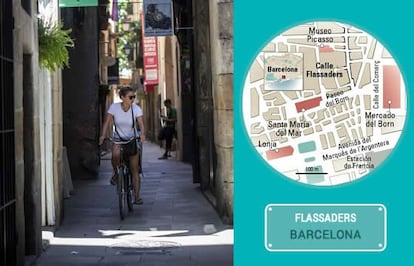
A microcosm in 46 numbers
By Clara Blanchar
It’s hard to believe that there can be so much on offer in a street of just 46 buildings. There is a wine cellar, a hundred-year-old herbalist, a tiny theater, a jewelers, a luxury bakers, a bio restaurant, a tapas market for tourists, a corner store run by a Pakistani, a bathroom store, and a number of medium- to high-level fashion stores. This is Flassaders, a narrow street in Barcelona’s Born neighborhood.
The word Flassaders comes from flassada, meaning blanket in Catalan. Like other streets in the area, it took its name from the specialty of the craftsmen based on the street.
Flassaders begins just above Princesa street, and ends on Paseo del Born. In the middle it spreads out to form the Jaume Sabartés square, where the Museo Picasso has opened a new entrance and there are three terrace bars where you can enjoy a drink.
There are no establishments here without a long history. The Princesa tapas market, which boasts 17 stalls, finds its home in a palace from the year 1400. The restaurant La Báscula, which specializes in organic produce, was a former candy and chocolate factory, and takes its name from the scales upon which carts used to be weighed – and upon which it now stands. Its owners took a brave step when they opened it in 2001, a time when Born had not yet become fashionable. Even before then, the store Èstro had opened, which specializes in shoes, fur accessories and clothing made of natural fibers – all designed and made in Italy.
The street is also home to JS Heritage, the casual range from Javier Simorra; the Roser Marcè bridal and party store; and jeweler Elisa Brunells, a city classic. Other options carry a variety of brands, such as Loisaida, which sells clothes from a number of Catalan designers, as well as antiques. The impressive premises comprise what used to be the stables of the old mint, La Seca, which today is a theater with two stages, and an excellent program.
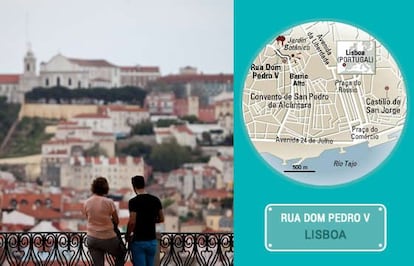
Under the shade of the magnolia trees
By Javier Martín
There are streets, and then there are streets that take you somewhere; there are day streets and night streets; streets for kids and streets for shopaholics; streets for walking and streets for driving. But in just 500 meters, Rúa Dom Pedro V manages to bring them all together.
It starts at one end with the best viewpoint in the whole of Lisbon, and with the convent of St Peter of Alcántara at the other. Neither sidewalk takes precedence over the other on this street lined with jacaranda trees with their purplish blue flowers on display. Between its two ends, the rúa is given over to bodily sin. It is worth getting started at the San Roque bakery, to be followed by another stop – money will not be a problem here – at Doce Real to sample its savory empadas de galinha pastries.
Between the two you’ll come across the opening to another street, Rúa da Rosa, which is charming by day but diabolical by night – make a note of it for later. In the meantime, keep going to reach a string of boutiques that vie with each other to offer the latest fashion trends. Then cross the road to jump five centuries back in time.
If there are monuments that justify visiting a city, the same is occasionally true of some stores. This is the case with antiques shop Solar. Lucilia, the passionate clerk who works here, needs only a minute to explain the history of the white-and-blue tiles that were associated with Portugal between the 16th and 20th centuries.
Temptation is strong in this store, because who cannot afford to spend €20 on acquiring a real antique? Unlike other places, Lucilia gets offended when tourists walk in and out without taking the time to look around. “But you haven’t seen anything yet!” she tells them reproachfully in whatever language is called for. Old and new combine as well here as the luxury menus and bargain €5.95 daily specials do at Tascardoso, at the other end of the street.
Dom Pedro V opens up into the Principe Real gardens, with their old cypress and giant magnolia trees encircling the outdoor Esplanada café. When evening falls, the square’s two kiosks fill up with beautiful people. This is the right place and right time to take your poodle out for a walk or your Porsche for a drive. Enjoy dinner at A Cevicheria, and cocktails at the Pavelhao Chinés, another unique spot. From day to night, from the nunnery to the drinks bar: it’s all there on Dom Pedro V, the rúa of rúas.
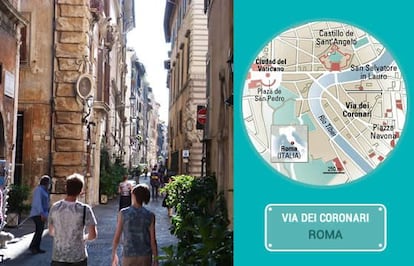
Where sacred and secular walk hand in hand
By Pablo Ordaz
It was inside the luxury antique shops located at one end of Via dei Coronari, just steps away from Piazza Navona, that Silvio Berlusconi used to buy presents for the young women who attended his notorious parties. At the other end of this street, on the left-hand side, Jorge Mario Bergoglio said his last prayer in front of the Madonna dell’Archetto before walking into the conclave that named him Pope Francis. The humorist Maurizio Crozza always says that Rome is the only city in the world that is the capital of two states: “One of them believes in God and is always waiting for a great miracle to happen; the other one is the Vatican.”
The street whose beauty brings these two worlds together is an oddly straight line covering around half a kilometer – “in Italy, the shortest distance between two points is the arabesque,” as the writer Ennio Flaiano used to say. The Via dei Coronari joins together the foundations on which the city’s glory creakily rests: the sacred and the secular, the historical and the ephemeral, the square with its fountain and church, and the alley – the narrowest one in town, they say – leading to a small palace that once belonged, back in the 15th century, to Fiammetta, the most celebrated courtesan in all of Rome, but which is now home to a financial institution.
Halfway down the street, right after crossing the picturesque alley that houses the Gelateria del Teatro ice cream parlor, is the church of San Salvatore in Lauro, built in the 16th-century over the original 11th-century temple. Inside, the relics of several saints are on display to fuel the amazement of unbelievers and the devotion of the faithful. Chief among these are the remains of Pio of Pietrelcina, a Capuchin friar who lived between 1887 and 1968 and was famous for the unexplained stigmata that appeared on his hands.
If you were to take a walk from here in the direction of the Bridge of Sant’Angelo each week, it would become evident that the neighbors’ complaints are true: that the beautiful and unassuming establishments that once lined this street are rapidly being replaced with cheap stores and fast-food joints. Tramping upon the sampietrini – the typical Roman cobblestones – of Via dei Coronari also provides further proof that the beauty of Rome also constitutes its greatest threat.
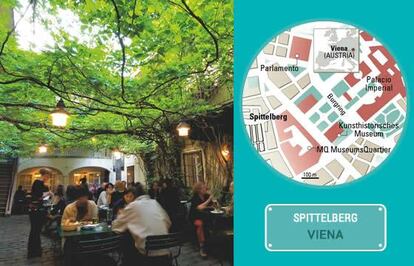
A hill that feels like a village
By José Miguel Roncero
Major capitals such as Vienna have many broad, majestic-looking avenues that evoke memories of a glorious past – this year marks the 150th anniversary of the Ringstrasse, the ring road that encircles the Austrian capital’s expansion. And then there are small, cozy-looking streets that hark back to a past when the city was more like a large village. Spittelberg (the hospital on the hill) – located in the seventh district, Neubau, and just a stone’s throw from the city’s Museum Quarter – is a good example of this.
Spittelberg, in fact, comprises three parallel streets: Spittelberggasse, Schrankgasse and Gutenberggasse. Stepping inside the area is like entering a small, cobblestoned hamlet, free of noise and cars. The hill’s rural, agricultural past is still felt in some of its homes, which date back to the 17th century. A few buildings appear to stretch themselves up, as though trying to get the best views. At one point, Spittelberg was an underworld of prostitutes, hustlers and other rabble: Vienna’s bureaucratic rationalism did not impose itself here until well into the 19th century, when the simplicity and elegance of Biedermeier architecture found its way in – excellent examples of it still abound.
Today, though, things have changed. Now you go to Spittelberg to stroll around, sip a cup of coffee, have a drink with friends, or find a unique gift for that special someone. The hill prides itself on its cuisine and its entertainment and cultural activities: there is a theater, a cinema, cafés, traditional and contemporary bars, art galleries, designer boutiques, chocolate shops and restaurants.
There is also a huge array of outdoor street activities. In the winter, one of Vienna’s most famous and most alternative Christmas markets takes place here. In the summer, the sidewalk cafés take over. And on the first weekend of every month there is a market selling handicrafts and antiques that look like they could have been pulled out of the nearby basements. Welcome to the hill.

500 years in 600 meters
By Isabel Ferrer
Located between two central squares, Rembrandtplein and Frederiksplein, Utrecht street (Utrechtsestraat) was created in 1658 when Amsterdam underwent a major expansion. It was the Golden Age, and this was one of Europe’s most prosperous cities.
Yet even though it crosses three of the city’s most notable canals – Herengracht, Keizersgracht and Prinsengracht – along its 600-meter length, few people think about this street when strolling around the city’s historic center. Its buildings are typically Dutch, but lack the impact of other constructions built by local traders who got rich speculating on tulips. What's more, a tramway also runs down Utrechtsestraat, meaning you need to take care when crossing it.
Yet in many ways, Utrechtsestraat embodies the essence of Amsterdam. Horse-drawn trams first arrived here in 1877, and electric ones in 1904. These days, as elsewhere in Amsterdam, bicycles vie with cars and trams for road space.
While few of the original buildings of five centuries ago are still standing, Utrechtsestraat’s appeal lies in its shops. There are fashion stores, interior decorators, restaurants, chocolate shops, jewelers, goldsmiths, florists, portraitists, tattoo parlors, perfumers, hairdressers, bakeries, delis, hardware stores, wine shops, bookstores and more.
Van Soest Chocolatier sells artisan chocolate; Bakker Van Eijk offers bread and other baked goods; Kaashuis Tromp has a selection of cheeses; Romeyn Tailors is a gentleman’s tailor shop founded in 1898; women can find colorful clothes and boots at Lien & Giel; unique gifts line the shelves at Jan; and Concerto, the largest used and new music store of its kind in the country, offers a wide selection of vinyl, compact discs and DVDs. The menu at Sluizer restaurant, opened in 1967, features classics such as tomato soup alongside more contemporary recipes.
Utrechtsestraat is also just a few steps from the Hermitage Museum, the Dutch branch of the famous Russian art center, housed in a former orphanage. The Carré Theater is nearby, too. Both of them look out over the Amstel River, and form part of the cultural activities on offer in this unpretentious street with an authentic feel.
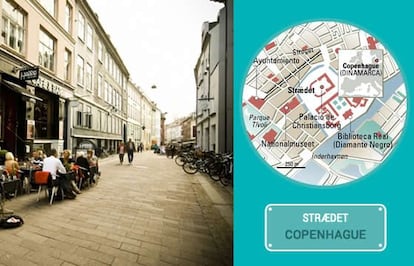
A date at the Kiss Café
By Viveca Tallgren
One of Copenhagen’s most charming streets, Strædet meanders through the heart of the medieval city. It runs parallel to the pedestrianized Strøget, but lacks that thoroughfare’s hustle and bustle – and its noise. It is easy to spend half a day on Strædet, jumping in and out of stores and contemplating its beautiful 18th-century buildings, some of them with half-timbered walls.
Strædet is in fact the common denominator for three back-to-back streets: Farvergade, Kompagnistræde and Læderstræde, which lead to Amagertorv, a square near the Christiansborg Palace, home of the Danish parliament.
Designer stores of all kinds line Strædet, offering everything from ceramics and jewelry, to clothing, furniture and used books. The workshop of ceramist Ditte Fischer, which is located at Læderstræde 14, is well worth a visit. Almost right across the way is one of Copenhagen’s most popular cafés, the Kafe Kys (the Kiss Café).
Designer Mette Grønlykke, on Læderstræde 5, offers a wide variety of home decor items, including pillows, lamps and baskets in bright colors. A bit further away, on Kompagnistræde 8, Kaiku displays exclusive and modern Scandinavian furniture, flower vases and other home items. Frietzsches, with its green storefront, sells exquisite handmade glassware.
Strædet also has an abundance of small cafés and bars to suit all tastes. Many have sidewalk terraces in the summer, and all of them share an informal atmosphere. Hoppes, on Læderstræde 7, is one of the most popular restaurants around, as is RizRaz, at Kompagnistræde 20, which serves Mediterranean cuisine and offers a large vegetarian buffet at a good price.
Bertels Salon, on Kompagnistræde 5, serves coffee and New York-style cheesecake, while Bar Maroc, a little further down, specializes in Moroccan mint tea and oriental pastries. There’s even a good hair salon, Atmosphair, which is run by three talented hairdressers.
Tu suscripción se está usando en otro dispositivo
¿Quieres añadir otro usuario a tu suscripción?
Si continúas leyendo en este dispositivo, no se podrá leer en el otro.
FlechaTu suscripción se está usando en otro dispositivo y solo puedes acceder a EL PAÍS desde un dispositivo a la vez.
Si quieres compartir tu cuenta, cambia tu suscripción a la modalidad Premium, así podrás añadir otro usuario. Cada uno accederá con su propia cuenta de email, lo que os permitirá personalizar vuestra experiencia en EL PAÍS.
¿Tienes una suscripción de empresa? Accede aquí para contratar más cuentas.
En el caso de no saber quién está usando tu cuenta, te recomendamos cambiar tu contraseña aquí.
Si decides continuar compartiendo tu cuenta, este mensaje se mostrará en tu dispositivo y en el de la otra persona que está usando tu cuenta de forma indefinida, afectando a tu experiencia de lectura. Puedes consultar aquí los términos y condiciones de la suscripción digital.
Últimas noticias
Most viewed
- Pablo Escobar’s hippos: A serious environmental problem, 40 years on
- Why we lost the habit of sleeping in two segments and how that changed our sense of time
- Charles Dubouloz, mountaineering star, retires at 36 with a farewell tour inspired by Walter Bonatti
- Reinhard Genzel, Nobel laureate in physics: ‘One-minute videos will never give you the truth’
- The Florida Keys tourist paradise is besieged by immigration agents: ‘We’ve never seen anything like this’








































